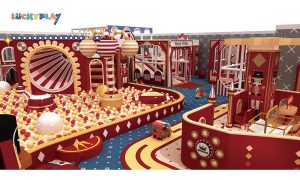Introduction to Indoor Playgrounds
Welcome to the world of indoor playgrounds – a vibrant and exhilarating haven for kids filled with laughter, adventure, and boundless fun! In today’s fast-paced digital age, where children are often glued to screens, indoor playgrounds provide a breath of fresh air by offering an immersive play experience that combines entertainment, exercise, and safety. Whether it’s climbing through tunnels, navigating obstacle courses or jumping on trampolines – there is something for every child at these bustling wonderlands. So join us as we explore the exciting world of indoor playgrounds and discover how they benefit our little ones in more ways than one!

Benefits of Indoor Playgrounds for Kids
Indoor playgrounds offer a wide range of benefits for kids, making them more than just a fun place to play. These interactive environments provide children with opportunities for physical exercise, social interaction, and cognitive development.
One of the main advantages of indoor playgrounds is that they promote physical fitness in a safe and controlled environment. Kids can engage in activities such as climbing walls, jumping on trampolines, and navigating obstacle courses. These activities help improve their balance, coordination, strength, and overall motor skills.
In addition to physical benefits, indoor playgrounds also encourage social interaction among children. They provide an opportunity for kids to make new friends while engaging in cooperative play activities. This helps develop important social skills like sharing, taking turns, and resolving conflicts.
Furthermore, indoor playgrounds stimulate cognitive development through imaginative play. Children can explore different themed areas or engage in pretend play using props and costumes provided by the facility. This type of play encourages creativity and problem-solving abilities.
Parents also benefit from indoor playgrounds as they provide a safe space for their children to burn off energy while keeping an eye on them. Indoor facilities are designed with safety measures in mind – soft padding on floors and equipment reduces the risk of injuries.
How Indoor Playgrounds Promote Fitness and Physical Development
Indoor playgrounds are not just about fun and games – they also play a crucial role in promoting fitness and physical development among children. These vibrant spaces are designed to engage kids in various activities that get their bodies moving, helping them develop strength, endurance, coordination, and balance.
One of the key ways indoor playgrounds promote fitness is by offering a wide range of equipment and structures for kids to climb, slide, swing, jump, and crawl through. From obstacle courses to climbing walls and trampolines, these versatile settings allow children to challenge themselves physically while having a blast. They can improve their gross motor skills as they navigate through different obstacles or learn how to balance on beams or ropes.
In addition to the structured play areas, many indoor playgrounds also provide opportunities for more organized activities like dance classes or sports programs. These classes introduce children to new forms of exercise while teaching them important skills such as teamwork and discipline. This helps foster a love for an active lifestyle from an early age.
Furthermore, indoor play areas often incorporate interactive games that stimulate both body and mind. Whether it’s playing virtual reality games that require physical movements or participating in sensory-based activities like ball pits or foam pits where they can dive into soft surfaces – these experiences encourage kids’ overall physical development by engaging all their senses.
Moreover, many indoor playgrounds offer dedicated zones for specific types of exercises such as gymnastics or yoga studios. These specially designed areas allow children to focus on developing specific muscle groups while improving flexibility and body awareness.

Different Types of Activities Offered in Indoor Playgrounds
Indoor playgrounds are a treasure trove of activities that cater to every child’s interests and abilities. From climbing walls to ball pits, these play spaces offer a wide variety of fun-filled experiences for kids of all ages.
One popular activity in indoor playgrounds is the obstacle course. Kids can challenge themselves by navigating through tunnels, balancing on beams, and conquering various physical obstacles. This not only keeps them engaged but also helps improve their coordination and balance.
Another favorite among children is the trampoline area. Jumping on trampolines not only brings joy but also provides an excellent cardiovascular workout. It allows kids to release their energy while improving their stamina and strengthening their muscles.
Many indoor playgrounds also feature interactive games like laser tag or virtual reality experiences. These activities promote problem-solving skills, strategic thinking, and teamwork among children as they engage in friendly competition with their peers.
For those who enjoy more creative pursuits, arts and crafts areas are available where kids can unleash their imagination through painting, drawing, or crafting projects. These activities encourage self-expression while fostering fine motor skills development.
Additionally, some indoor playgrounds offer sensory play areas equipped with materials like sand or water tables that stimulate different senses such as touch or sight. These spaces provide valuable sensory experiences for young children while promoting exploration and discovery.
The Importance of Social Interaction in an Indoor Playground Setting
Social interaction plays a vital role in the development of children. In an indoor playground setting, it becomes even more important as kids have the opportunity to engage with their peers and learn essential social skills.
Interacting with other children helps kids develop communication skills. They learn to express themselves, listen to others, and cooperate in group activities. These interactions enhance their ability to effectively communicate their needs and ideas.
Social interaction promotes empathy and understanding among children. They learn to consider others’ perspectives and feelings, fostering a sense of compassion and respect towards others.
Furthermore, playing with peers encourages teamwork and collaboration. Children can work together on challenges or participate in group games that require cooperation. This builds their ability to work well in teams later on in life.
Moreover, social interaction at indoor playgrounds allows children to practice conflict resolution skills. As they navigate through different situations while playing, they learn how to manage conflicts peacefully and find solutions that benefit everyone involved.
Engaging with other kids fosters a sense of belongingness and community for children. It provides them with opportunities for making new friends from diverse backgrounds which contributes positively towards building strong interpersonal relationships.

Tips for Parents to Maximize Their Child’s Experience at an Indoor Playground
1. Choose the right time: Consider visiting the indoor playground during off-peak hours to avoid overcrowding and long wait times. This will allow your child to have more space and enjoy their playtime to the fullest.
2. Dress appropriately: Make sure your child is dressed comfortably in clothes that are suitable for physical activity. Avoid clothing with buttons or zippers that can get caught on equipment.
3. Encourage exploration: Let your child freely explore all the different areas of the indoor playground, from climbing structures to ball pits. Allow them to discover new activities and challenge themselves physically.
4. Set boundaries: While it’s important to let your child explore, also establish some ground rules for safety purposes. Teach them about sharing, taking turns, and respecting other children’s personal space.
5. Engage in play together: Join in on the fun! Collaborate with your child by participating in games or helping them navigate through obstacles if needed. Spending quality time together will strengthen your bond while enhancing their experience.
6. Stay vigilant: Keep a watchful eye on your child at all times, ensuring they are playing safely and following any posted rules or guidelines provided by the facility.
By following these tips, you can help maximize your child’s experience at an indoor playground while fostering their physical development and social skills.
Conclusion
In today’s digital age, where children are increasingly becoming sedentary and glued to screens, it is more important than ever to provide them with opportunities for physical activity and social interaction. That’s where indoor playgrounds come in. These vibrant spaces not only offer a fun-filled experience but also promote fitness, physical development, and safety for kids.
Indoor play areas provide numerous benefits for children of all ages. From enhancing gross motor skills to boosting cognitive abilities, these facilities offer a wide range of activities that cater to each child’s unique interests and capabilities. Whether it’s climbing structures, slides, ball pits or trampolines, children can engage in active play while developing their coordination and balance.
One of the major advantages of indoor playgrounds is their ability to promote fitness among children. With increasing concerns about childhood obesity and related health issues, providing a space where kids can engage in active play is crucial. These dedicated play zones encourage them to run, jump, climb and explore different challenges – all while having a great time! By incorporating physical activity into their routine through regular visits to an indoor playground facility, children can develop healthy habits that will benefit them throughout their lives.
Moreover, indoor playgrounds foster social interaction among children from diverse backgrounds. As they navigate through various play elements together – whether it be crossing bridges or crawling through tunnels – they learn invaluable skills such as teamwork cooperation and communication. Interacting with peers also helps enhance their emotional intelligence by promoting empathy and understanding.









